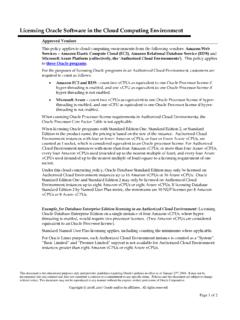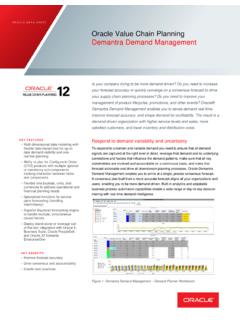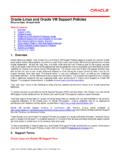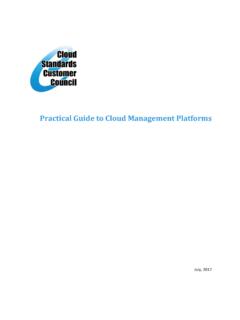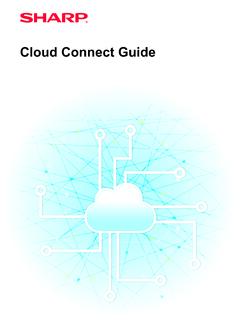Transcription of Oracle Cloud Infrastructure Virtual Cloud Network …
1 Virtual Cloud Network Overview and Deployment guide Oracle WHITE PAPER | JUNE 10, 2019 CONTENTS Virtual Cloud Network Overview and Deployment guide 3 Purpose of this White Paper 3 Scope and Assumptions 3 Virtual Cloud Network (VCN) Overview 4 Other Components 5 VCN Connectivity 11 Scenarios for Using a VCN 13 VCN Security Lists 18 References 20 Revision History 20 Oracle Cloud Infrastructure 2 Virtual Cloud Network Overview and Deployment guide Purpose of this White Paper The purpose of this document is to provide a basic understanding of the Oracle Cloud Infrastructure Networking service and common deployment scenarios for a Virtual Cloud Network (VCN). You should have basic knowledge of networking and internet routing to understand this document.
2 It is not intended to be a production deployment reference architecture. Scope and Assumptions This document gives brief descriptions of various Networking service components and typical deployment scenarios. After reading this document, you should have a good understanding of what a VCN is and several scenarios that illustrate VCN usage. You should first: lBe familiar with the fundamentals of Oracle Cloud Infrastructure o lHave a basic understanding of Oracle Cloud Infrastructure Compute o lHave a basic understanding of Oracle Cloud Infrastructure Networking o lHave a basic understanding of IPSec VPN tunnel functionality o lHave a basic understanding of Oracle Cloud Infrastructure FastConnect o There are a number of other related products and components that are used during typical VCN deployments, such as Identity and Access Management (IAM).
3 Their details are beyond the scope of this document. Oracle Cloud Infrastructure 3 Virtual Cloud Network (VCN) Overview A VCN is a Virtual , private Network that you set up in Oracle data centers. It closely resembles a traditional Network , with firewall rules and specific types of communication gateways that you can choose to use. A VCN resides in a single Oracle Cloud Infrastructure region and covers a single, contiguous IPv4 CIDR block of your choice. The allowable VCN size range is /16 to /30. Example: The Networking service reserves the first two IP addresses and the last one in each subnet's CIDR. After you've created a VCN or subnet, you can't change its size, so it's important to think about the size of VCN and subnets you need before creating them.
4 For your VCN, Oracle recommends using one of the private IP address ranges specified in RFC 1918 ( , , and ). However, you can use a publicly routable range. Your VCN automatically comes with these default components: lDefault route table, with no rules lDefault security list, with default rules lDefault set of DHCP options, with default values You can't delete these default components. However, you can change their contents (for example, the rules in the default security list). And you can create your own custom versions of each kind of component in your VCN. There are limits to how many you can create and the maximum number of rules. The following diagram is a simple illustration of a VCN with two regional subnets (which means the subnet spans all availability domains in the region).
5 Each subnet contains instances in both availability domains. Subnet A uses the default route table, and Subnet B uses a custom route table (which you can create). Both subnets use the default security list as well as their own custom security lists. The default set of DHCP options is not explicitly shown in the diagram. The diagram also shows a couple of components that are not default components: a dynamic routing gateway (DRG) and an internet gateway. Keep reading for further discussion of these components. Oracle Cloud Infrastructure 4 Other Components This section covers other Networking service components. Subnet Subnets are subdivsions you define in a VCN (for example, and ). Subnets contain Virtual Network interface cards (VNICs), which attach to instances.
6 Each subnet consists of a contiguous range of IP addresses that do not overlap with other subnets in the VCN. You can designate a subnet to exist either in a single availability domain or across an entire region (regional subnets are recommended). Subnets act as a unit of configuration within the VCN: All VNICs in a given subnet use the same route table, security lists, and DHCP options (see the definitions that follow). You can designate a subnet as either public or private when you create it. Private means VNICs in the subnet can't have public IP addresses. Public means VNICs in the subnet can have public IP addresses at your discretion. Virtual Network Interface Card (VNIC) A VNIC attaches to an instance and resides in a subnet to enable a connection to the subnet's VCN.
7 The VNIC determines how the instance connects with endpoints inside and outside the VCN. Each instance has a primary VNIC that's created during instance launch and cannot be removed. You can Oracle Cloud Infrastructure 5 add secondary VNICs to an existing instance (in the same availability domain as the primary VNIC), and remove them as you like. Each secondary VNIC can be in a subnet in the same VCN as the primary VNIC, or in a different subnet that is either in the same VCN or a different one. However, all the VNICs must be in the same availability domain as the instance. Here are some reasons why you might use secondary VNICs: lUse your own hypervisor on a bare metal instance lConnect an instance to subnets in multiple VCNs Here are more details about secondary VNICs: lThey're supported for these types of instances: o Linux: Both VM and bare metal instances.
8 O Windows: Both VM and bare metal instances, but only on X7/second-generation shapes (shapes with "2" in the name, such as and ). For bare metal, secondary VNICs are supported only on the second physical NIC. lThere's a limit to how many VNICs can be attached to an instance, and it varies by shape. lThey can be added only after the instance is launched. lThey must always be attached to an instance and cannot be moved. The process of creating a secondary VNIC automatically attaches it to the instance. The process of detaching a secondary VNIC automatically deletes it. lThey are automatically detached and deleted when you terminate the instance. lThe instance's bandwidth is fixed regardless of the number of VNICs attached.
9 You can't specify a bandwidth limit for a particular VNIC on an instance. lAttaching multiple VNICs from the same subnet CIDR block to an instance can introduce asymmetric routing, especially on instances using a variant of Linux. If you need this type of configuration, Oracle recommends assigning multiple private IP addresses to one VNIC, or using policy-based routing. Private IP A private IP consists of a private IP address and related information for addressing an instance (for example, a hostname for DNS). Each VNIC has a primary private IP, and you can add and remove secondary private IPs. The primary private IP address on an instance doesn't change during the instance's lifetime and cannot be removed from the instance.
10 You can add a secondary private IP to an instance after it's launched. You can add it to either the primary VNIC or a secondary VNIC on the Oracle Cloud Infrastructure 6 instance. The secondary private IP address must come from the CIDR of the VNIC's subnet. You can move a secondary private IP from a VNIC on one instance to a VNIC on another instance if both VNICs belong to the same subnet. Here are a few reasons why you might use secondary private IPs: lInstance failover lRunning multiple services or endpoints on a single instance Here are more details about secondary private IP addresses: lThey're supported for all shapes and OS types, for both bare metal and VM instances. lA VNIC can have a maximum of 31 secondary private IPs.
